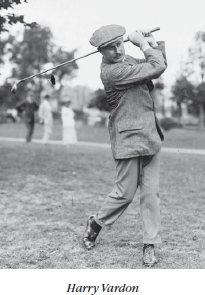Current Swing Trends On Tour
 In the last issue of Golf Teaching Pro, there was an article about current trends in coaching golf. The trend towards multiple coaches was particularly highlighted. In this article, we will focus on the swing itself, and what the top players in the world are gravitating towards.
In the last issue of Golf Teaching Pro, there was an article about current trends in coaching golf. The trend towards multiple coaches was particularly highlighted. In this article, we will focus on the swing itself, and what the top players in the world are gravitating towards.
First, here’s a brief history of the golf swing. In the early days of golf in Scotland, a relatively flat swing was utilized so that the ball could be kept low to the ground. Since the featherie golf ball did not have the best of aerodynamic properties, it was best to keep it low to the ground. When the gutta percha ball was invented, players still played with a flatter swing plane, until Harry Vardon and other players from Jersey were noted for their success with a higher swing plane.
When the wound Haskell ball became the standard, the swing plane became even more upright. Ben Hogan later had success with a flatter plane, and his famous pane-of-glass illustration became the standard for awhile. That all went out the window when Jack Nicklaus entered the arena, with his high hands and strong lateral leg drive. Nicklaus’ motion became the standard throughout the 1960s and ’70s, and one of its most notable practitioners was Johnny Miller, whose laser-like iron play was the envy of all.
David Leadbetter influenced a generation of golfers with his work with Nick Faldo. Faldo went from the Nicklaus/Miller model to a more rotary move, emphasizing the body controlling the action. Leadbetter’s swing philosophy involved the backswing turning around an axis located on the right side of the body, and a forward swing turning around an axis located on the left side. This swing pretty much became the “ideal” for a tour player for many years, and is still employed by a large number of professional players around the world.
In examining the swings of modern-day tour players, two things are becoming apparent:
1) More players are gravitating toward a flatter or “one-plane” swing;
2) More homemade swings are becoming successful at the highest levels of the game.
Flatter swings and centered swings
 Instructor Jim Hardy has been instrumental in promoting a flatter “one-plane” swing as simpler to execute. Hardy describes a one-plane swing as one where, at the top of the backswing, the lead arm is relatively in-line with the shoulder plane. With this motion, the grip is relatively strong, and the downswing is initiated by more of a turning of the upper body and torso rather than with a strong hip rotation or leg motion. Teachers and advocates of this motion don’t believe in rotating around a right axis on the backswing and around a left axis on the forward swing. Rather, they believe the swing should rotate around a centered axis. Prominent golfers who use what can be described as a one-plane swing include Matt Kuchar, Zach Johnson, Jason Dufner, Lee Westwood, and Ricky Fowler.
Instructor Jim Hardy has been instrumental in promoting a flatter “one-plane” swing as simpler to execute. Hardy describes a one-plane swing as one where, at the top of the backswing, the lead arm is relatively in-line with the shoulder plane. With this motion, the grip is relatively strong, and the downswing is initiated by more of a turning of the upper body and torso rather than with a strong hip rotation or leg motion. Teachers and advocates of this motion don’t believe in rotating around a right axis on the backswing and around a left axis on the forward swing. Rather, they believe the swing should rotate around a centered axis. Prominent golfers who use what can be described as a one-plane swing include Matt Kuchar, Zach Johnson, Jason Dufner, Lee Westwood, and Ricky Fowler.
Sean Foley’s swing philosophy is much in-line with this school of thought, even if he doesn’t necessarily advocate a one plane swing, and his most famous student, of course, was Tiger Woods. Foley has also overseen the success of his other students such as Hunter Mahan and Justin Rose, who also employ this centered-swing motion. While it may not be necessary to swing on one plane with a centered motion, the centeredmotion swing is also enjoying a gain in popularity on the world stage.
Homemade swings
 The poster boy for homemade swings for the past couple of decades is undoubtedly Jim Furyk, whose swing was once described by David Feherty as looking like an octopus falling out of a tree. While that may be somewhat of an exaggeration, it also shows that homemade swings can and do win at the highest levels.
The poster boy for homemade swings for the past couple of decades is undoubtedly Jim Furyk, whose swing was once described by David Feherty as looking like an octopus falling out of a tree. While that may be somewhat of an exaggeration, it also shows that homemade swings can and do win at the highest levels.
The latest homemade swinger to make a real splash is current Masters champion Bubba Watson. Watson has never had any lessons, which has resulted in a swing that no teaching professional would recommend. Watson’s hands are extremely high at the top of his backswing, and his footwork, where his lead foot sometimes hops up into the air and is repositioned to the right through impact, leaves a lot to be desired. It’s hard to argue with Watson’s results, although it could also be argued that if Watson had taken proper instruction during his formative years, he would perhaps have won twice as many tournaments and majors as he already has, and wouldn’t have taken so long to reach the Tour.
Why are there more homemade swings popping up on Tour? We believe it could be the result of the trend of teachers the past decade or so to emphasize hitting the ball as far as you can off the tee. Also, sports psychology has perhaps played an important role, as the message of repeatability instead of perfection seems to be taking hold.
Conclusion
 Unlike other sports, golf has an assortment of body types that are all trying to do the same thing. Take the NFL, for example. Offensive lineman almost all fit the same profile, over six feet tall and around 310 lbs. You can go to any position on the football field and almost all the players at that position are relatively similar in size and physique. Therefore, the same techniques employed by one player can transfer to all the other players at that position.
Unlike other sports, golf has an assortment of body types that are all trying to do the same thing. Take the NFL, for example. Offensive lineman almost all fit the same profile, over six feet tall and around 310 lbs. You can go to any position on the football field and almost all the players at that position are relatively similar in size and physique. Therefore, the same techniques employed by one player can transfer to all the other players at that position.
Golf only has one “position,” that of golfer. Because of all the different body types and physiques, it doesn’t make sense that every golfer should use the same technique. Basic fundamentals apply to all golfers, but swing variations within the framework of these fundamentals are perfectly acceptable in order to meet the needs of the individual golfer, providing that they’re repeatable.




